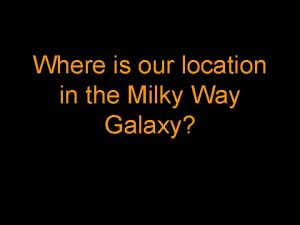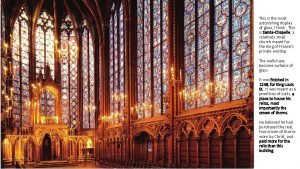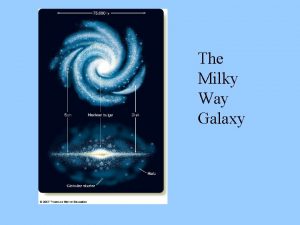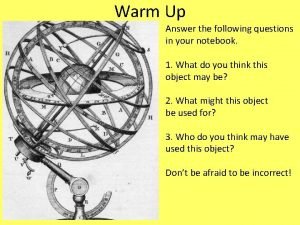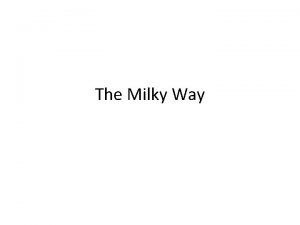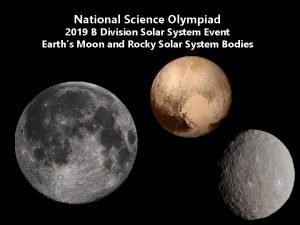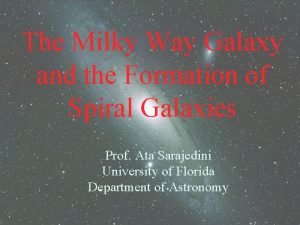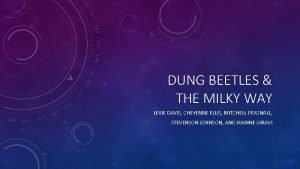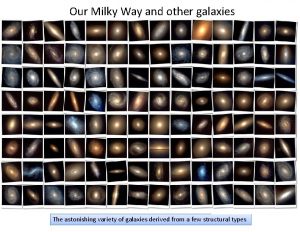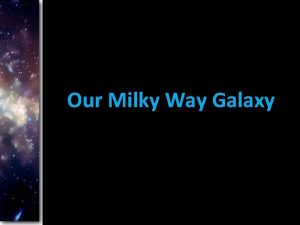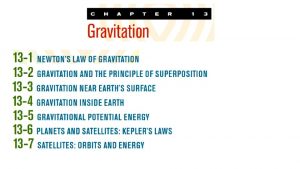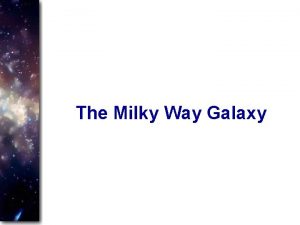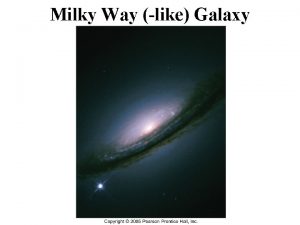Our Milky Way and other galaxies The astonishing



![The Field of (stellar) Streams [SDSS] Globular cluster Dwarf galaxy Credit: V. Belokurov and The Field of (stellar) Streams [SDSS] Globular cluster Dwarf galaxy Credit: V. Belokurov and](https://slidetodoc.com/presentation_image_h/166224378199d1bcefe51bd5075b99f0/image-4.jpg)




- Slides: 8

Our Milky Way and other galaxies The astonishing variety of galaxies derived from a few structural types

Sec 1. 2 The Milky Way – a prototypical barred spiral galaxy Metal poor halo stellar population Clouds of neutral H Principal structural components Galactic halo Stellar disk (thin/thick) Bulge (spheroid) Nucleus (SMBH) Disk of dust and dense gas SMBH Stellar masses (in Msun) Disk 6 E 10 Bulge 2 E 10 Halo 1 E 9 SMBH Corona and Dark Matter halo 4 E 6 Distances (kpc = 3 E 16 km) Bulge radius ~ few kpc Disk radius ~15 kpc Sun ~8. 5 kpc from center.

Milky Way lookalikes! Grand Design Spiral (SBb-SBc) Spiral arms (propagating density waves, not pin wheel, solid body rotation) Bulge + nucleus (SMBH) Central bar (secular/ disk instability) Face-on view Halo GC, stellar populations, hot corona Credit: N. Resinger Warped disk (mergers/interactions) Dust lanes (active star formation, massive, young stars, SNe II) Edge-on view
![The Field of stellar Streams SDSS Globular cluster Dwarf galaxy Credit V Belokurov and The Field of (stellar) Streams [SDSS] Globular cluster Dwarf galaxy Credit: V. Belokurov and](https://slidetodoc.com/presentation_image_h/166224378199d1bcefe51bd5075b99f0/image-4.jpg)
The Field of (stellar) Streams [SDSS] Globular cluster Dwarf galaxy Credit: V. Belokurov and the SDSS In the figure, color = distance to stars, intensity = density of stars. Shown are stellar streams from dwarf galaxies and globular clusters in the northern sky. Circles indicate newly discovered dwarf galaxies (12) and globular clusters (2) by SDSS. The stellar content of the Milky Way Ø Estimated number of stars ~ 200 billion Ø Majority from in-situ star formation in the spiral arms, with the current SFR ~ 1 Msun. y -1 Ø A sizeable fraction from accretion of satellites (see ‘Field of Streams’)

Structural components of the Milky Way The Disk component: v Thin, nearly circular disk containing stars, gas and dust. v Exhibits circular rotation about the nucleus with small random motions v At the radius of the sun, V = 200 km. s-1. Orbital period = 250 Myr v Spiral arms are density waves propagating through the disk, and form centers of star formation in the Giant Molecular (H 2) Clouds (GMC). Luminosity: (15 – 20) x 109 Lsun Stellar mass: 60 x 109 Msun Thin Disk contains 95% of stars. Young, massive stars, ongoing SF Thick Disk contains remaining disk stars; Older, more evolved stars Stellar density, n(R, z) falls off exponentially in both the radial (R) and vertical (z) directions: Disk scale radius, h. R = 2. 5 – 3. 5 kpc Scale height, hz : Thin disk = 300 – 400 pc, Thick disk = 1 kpc

Structural components of the Milky Way The Bulge (spheroid) and nucleus: v Spherical concentration of stars (radius~1 -2 kpc); not related to the halo. v Mainly old, evolved stellar population, but nuclear star clusters. v Rotational velocity, Vrot ~ 100 km. s-1; stars show large random motions v Mean metallicity ~ 0. 5 Zsun, but also metal rich population ~ 3 Zsun v Dust extinction ~30 Vmag; best observed in IR Luminosity: 5 x 109 Lsun Stellar mass: 20 x 109 Msun Ø Central torus ( r < 2 pc) with gas (M~106 Msun) and (two? ) star clusters(M~106 Msun, ~30 massive stars), active star formation Ø Central stars (r < 0. 05 pc) show Keplerian orbits indicative of a SMBH (M~4 x 106 Msun) [ see: http: //www. astro. ucla. edu/~ghezgroup/gc/science. html

Structural components of the Milky Way The stellar/ dark halo: v Only old evolved stellar population, no star formation v Very metal-poor stars observed v No circular rotation. Exhibit highly eccentric orbits v Stars with high proper motion, hyper-velocity stars (3 -body interaction? ) v Stellar streams from accretion events (‘Field of streams’) v Low stellar density, stellar mass ~ 1 x 109 Msun v Globular clusters contribute a small fraction of the total stellar content v Coronal high temperature gas at 105 – 106 K v 90% of galaxy mass resides in Dark Matter, whose nature is unknown! v Dark Matter mass inferred from rotation curves (covered in Ch. 3)

Metal content and metallicity BBN Nuclear burning SNe production Read article by Asplund, Grevasse & Sauval (Astro-ph 0410214) Metals (heavy elements) = all elements heavier than Helium Solar photosphere: H 72%, He 26%, metals 2% => Zsun, fraction by mass of metals = 0. 02 Metallicity: Similarly for other elements. Fe is used as proxy for all heavy elements (metals).
